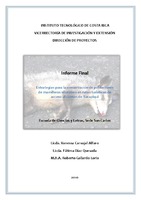Mostrar el registro sencillo del ítem
Estrategias para la conservación de poblaciones de mamíferos silvestres en rutas turísticas de acceso al cantón de Sarapiquí
| dc.contributor.author | Carvajal-Alfaro, Vanessa | |
| dc.contributor.author | Díaz-Quesada, Fátima | |
| dc.contributor.author | Gallardo-Loría, Roberto | |
| dc.date.accessioned | 2015-09-29T20:09:19Z | |
| dc.date.available | 2015-09-29T20:09:19Z | |
| dc.date.issued | 2010 | |
| dc.identifier.uri | https://hdl.handle.net/2238/6281 | |
| dc.description | Proyecto de Investigación. Instituto Tecnológico de Costa Rica. Vicerrectoría de Investigación y Extensión (VIE). Escuela de Ciencias y Letras; Colegio Científico Costarricense. Instituto Tecnológico de Costa Rica, Sede San Carlos, 2010 | |
| dc.description.abstract | In recent years it has increased the concern and interest in determining the negative effects and mitigation actions to the impact of road networks on the environment. The objective of This project was to implement strategies for the conservation of mammal populations wild that are vulnerable to being hit tourist paths in the canton of Sarapiqui. The number of wild mammals trampled method recorded by direct counts along Route 126 from San Miguel de Sarapiqui to the Virgin (secondary roads) following Route 4 from Chilamate, Puerto Viejo, El Tigre, Horquetas, San Jorge to Santa Clara for a study area of 63 5 kilometers. Two monthly monitoring between 6:00 AM and 9:00 am made were identified and recorded monthly in a database. Road segments with more deaths were determined. They georeferenced with a GPS Garmin 76Cx, during the year 2009. A land use map was developed, is segments determined as fewer and larger forest 10 hectares on both sides of the road, and death points trampled species found in 2009 were placed. Environmental education plan was developed with the activities that were implemented to 146 children, of near schools sampling route. A total of 39 field surveys were conducted for a sample area of 2476.5 kilometers, in this period were counted and identified a total of 231 animals killed on the road, the 91 which correspond to wild mammals, 55 violations were recorded in 2008 and 36 in the 2009. 91 were found wild mammals, a total of 86 individuals were identified, these are distributed five orders, seven families and eight species. Two species, the opossum (Didelphis marsupials) and armadillo (nine-banded armadillo) are the species most commonly killed by accident found a total of 62 individuals, there is a clear dominance of species Didelphis marsupials register more half of the abuses. The road segment comprised between Santa Clara and Cruce Forks, priority would be to establish high passes faunas. While the mortality of individuals is the most noticeable effect, roads and traffic flow, It has numerous consequences on wildlife. | es |
| dc.description.abstract | En los últimos años se ha incrementado la preocupación y el interés por determinar los efectos negativos y las acciones de mitigación ante el impacto de las redes viales en el medio ambiente. El objetivo del presente proyecto fue Implementar estrategias para la conservación de poblaciones de mamíferos silvestres que son vulnerables a ser atropelladas en rutas turísticas de acceso al cantón de Sarapiquí. El número de mamíferos silvestres atropellados se registró por método de conteos directos a lo largo de la ruta 126 desde San Miguel de Sarapiquí hasta la Virgen (red vial secundaria) siguiendo la ruta 4 desde Chilamate, Puerto Viejo, El Tigre, Horquetas, San Jorge hasta Santa Clara para un área de estudio de 63, 5 kilómetros. Se realizaron dos monitoreos mensuales entre 6:00 a.m. y 9:00 a.m. Se identificaron y registraron mensualmente en una base de datos. Se determinaron los segmentos de la carretera con más decesos. Se georeferenciaron con un GPS Garmin 76Cx, durante el año 2009. Se elaboró un mapa de uso de suelo, se determinaron lo segmentos de bosque menos y mayores a 10 hectáreas a ambos lados de la carretera, y se colocaron los puntos de muerte de las especies encontradas atropelladas durante el 2009. Se elaboró un plan de Educación Ambiental con las actividades que fueron implementadas a 146 niños, de escuelas cercanas a la ruta de muestreo. Se realizaron un total de 39 muestreos de campo, para un área de muestreo de 2476,5 kilómetros, en este período se contabilizaron e identificaron un total de 231 animales atropellados en la carretera, de los cuales 91 corresponden a mamíferos silvestres, 55 atropellos se registraron durante el año 2008 y 36 en el año 2009. Se encontraron 91 mamíferos silvestres, se identificaron un total de 86 individuos, estos se distribuyen en cinco órdenes, siete familias y ocho especies. Dos especies el zorro pelón (Didelphis marsupiales) y el armadillo (Dasypus novemcinctus) son las especies que más se encontraron muertas por atropello con un total de 62 individuos, existe una clara dominancia de la especies Didelphis marsupiales que registro más de la mitad de los atropellos. El segmento de la carretera comprendido entre el Cruce Santa Clara y Horquetas, sería la prioridad para establecer pasa faunas elevados. | |
| dc.description.sponsorship | Instituto Tecnológico de Costa Rica. Vicerrectoría de Investigación y Extensión. | es |
| dc.language.iso | es | es |
| dc.publisher | Instituto Tecnológico de Costa Rica. | es |
| dc.rights | acceso abierto | es |
| dc.subject | Fauna | es |
| dc.subject | Factores | es |
| dc.subject | Educación | es |
| dc.subject | Especies | es |
| dc.subject | Habitát | es |
| dc.title | Estrategias para la conservación de poblaciones de mamíferos silvestres en rutas turísticas de acceso al cantón de Sarapiquí | es |
| dc.type | informe | es |
Ficheros en el ítem
Este ítem aparece en la(s) siguiente(s) colección(ones)
-
Informes de proyectos de investigación [169]
Investigación


